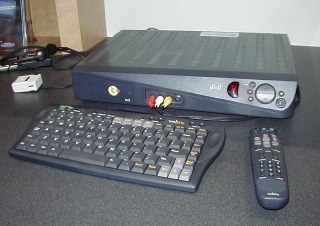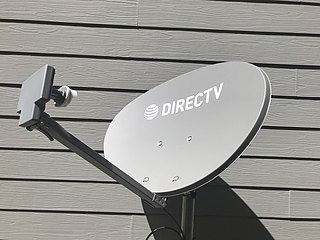
TiVo is a digital video recorder (DVR) developed and marketed by Xperi and introduced in 1999. TiVo provides an on-screen guide of scheduled broadcast programming television programs, whose features include "OnePass" schedules which record every new episode of a series, and "WishList" searches which allow the user to find and record shows that match their interests by title, actor, director, category, or keyword. TiVo also provides a range of features when the TiVo DVR is connected to a home network, including film and TV show downloads, advanced search, personal photo viewing, music offerings, and online scheduling.

Video on demand (VOD) is a media distribution system that allows users to access videos without a traditional video playback device and the constraints of a typical static broadcasting schedule. In the 20th century, broadcasting in the form of over-the-air programming was the most common form of media distribution. As Internet and IPTV technologies continued to develop in the 1990s, consumers began to gravitate towards non-traditional modes of content consumption, which culminated in the arrival of VOD on televisions and personal computers.

MSN TV was a web access product consisting of a thin client device which used a television for display, and the online service that supported it. The device design and service was developed by WebTV Networks, Inc., a company started in 1995. The WebTV product was announced in July 1996 and later released on September 18, 1996. In April 1997, the company was purchased by Microsoft Corporation and in July 2001, was rebranded to MSN TV and absorbed into MSN.

Multichannel Multipoint Distribution Service (MMDS), formerly known as Broadband Radio Service (BRS) and also known as Wireless Cable, is a wireless telecommunications technology, used for general-purpose broadband networking or, more commonly, as an alternative method of cable television programming reception.

Interactive television is a form of media convergence, adding data services to traditional television technology. Throughout its history, these have included on-demand delivery of content, as well as new uses such as online shopping, banking, and so forth. Interactive TV is a concrete example of how new information technology can be integrated vertically rather than laterally.
Pacific Telesis Group was one of the seven Regional Bell Operating Companies, sometimes also referred to as "RBOCs" or "Baby Bells", created in 1983 in preparation of the breakup of AT&T as a holding company for Pacific Bell and Nevada Bell, Pacific Telesis International and several other non-regulated companies including PacTel Mobile Services and PacTel InfoSystems. It was acquired by SBC Communications in 1997.

Sony Interactive Entertainment (SIE), formerly known as Sony Computer Entertainment (SCE), is a multinational video game and digital entertainment company wholly owned by Japanese multinational conglomerate Sony. The SIE Group is made up of two legal corporate entities: Sony Interactive Entertainment LLC (SIE LLC) based in San Mateo, California, United States, and Sony Interactive Entertainment Inc., based in Minato, Tokyo, Japan. Tokyo-based SIE Inc. was originally founded as Sony Computer Entertainment Inc. in November 1993 to handle Sony's venture into video game development for the PlayStation systems. SIE LLC was established in San Mateo in April 2016, and is managed through Sony's American branch, Sony Corporation of America.

Tele-Communications, Inc. (TCI) was a cable television provider in the United States, and for most of its history was controlled by Bob Magness and John Malone.

Sir Howard Stringer is a Welsh-American businessman. He had a 30-year career at CBS, culminating in him serving as the president of CBS News from 1986 to 1988, then president of CBS from 1988 to 2005. He served as chairman of the board, chairman, president and CEO of Sony Corporation from 2005 to 2012. He is also the head of the board of trustees of the American Film Institute and now serves as a non-executive director of the BBC. He was knighted in 1999.

The breakup of the Bell System was mandated on January 8, 1982, by an agreed consent decree providing that AT&T Corporation would, as had been initially proposed by AT&T, relinquish control of the Bell Operating Companies that had provided local telephone service in the United States and Canada up until that point. This effectively took the monopoly that was the Bell System and split it into entirely separate companies that would continue to provide telephone service. AT&T would continue to be a provider of long-distance service, while the now-independent Regional Bell Operating Companies (RBOCs), nicknamed the 'Baby Bells', would provide local service, and would no longer be directly supplied with equipment from AT&T subsidiary Western Electric.

AirTouch Communications was an American wireless telephone service provider, created as a spin-off on Pacific Telesis on April 1, 1994. Its headquarters were in One California in the Financial District, San Francisco, California. After a series of mergers, the company's vestiges are now part of Verizon Wireless.
A Technology and Engineering Emmy Award is given by the National Academy of Television Arts and Sciences (NATAS) for outstanding achievement in technical or engineering development. An award can be presented to an individual, a company, or to a scientific or technical organization for developments and/or standardization involved in engineering technologies which either represent so extensive an improvement on existing methods or are so innovative in nature that they materially have affected the transmission, recording, or reception of television. The award is determined by a special panel composed of highly qualified, experienced engineers in the television industry.
Michael Bavaro is a filmmaker and creative strategist based in Boston. He grew up in Milford, Massachusetts and graduated from Fitchburg State College in Fitchburg, Massachusetts with a B.S. degree in communications and received the "Communications Student of the Year Award" for film and television. In 1980 while at Fitchburg he produced a 16mm documentary film about his hometown of Milford. The film was part of the bicentennial celebration and featured WBZ radio personality, Larry Glick as the narrator.

DirecTV is an American multichannel video programming distributor based in El Segundo, California. Originally launched on June 17, 1994, its primary service is a digital satellite service serving the United States. It also provides traditional linear television service delivered by IP through its U-verse TV brand and a Virtual MVPD service through its DirecTV Stream brand. Its primary competitors are Dish Network, traditional cable television providers, IP-based television services, and other over-the-top video services.

Mediaroom is a collection of software for operators to deliver IPTV (IPTV) subscription services, including content-protected, live, digital video recorder, video on demand, multiscreen, and applications. These services can be delivered via a range of devices inside and outside customers' homes, including wired and Wi-Fi set top boxes, PCs, tablets, smartphones and other connected devices – over both the operator's managed IP networks as well as "over the top" (OTT) or unmanaged networks.

AT&T Inc. is an American multinational telecommunications holding company that is Delaware-registered but headquartered at Whitacre Tower in Downtown Dallas, Texas. It is the world's largest telecommunications company and the largest provider of mobile telephone services in the U.S. As of 2020, AT&T was ranked 9th on the Fortune 500 rankings of the largest United States corporations, with revenues of $181 billion.

Simeon Japhet Asher is an English film and television producer, writer and director who has worked in the United States for most of his career. Having moved back to England, he was the executive producer for interactive at CBBC, the BBC's programming strand for children, and an executive producer of the live action comedy Big Babies broadcast by that network.

Inview Technology is a UK-based digital TV software company. It specialises in advanced EPGs, interactive broadcast, IP services and solutions for Pay-TV and analogue switch off markets. Their OTT TV platform allows television broadcast and internet content to be simultaneously accessible to the viewer. The company is based in Northwich, Cheshire, UK and is privately owned.
The history of AT&T dates back to the invention of the telephone. The Bell Telephone Company was established in 1877 by Alexander Graham Bell, who obtained the first US patent for the telephone, and his father-in-law, Gardiner Greene Hubbard. Bell and Hubbard also established American Telephone and Telegraph Company in 1885, which acquired the Bell Telephone Company and became the primary telephone company in the United States. This company maintained an effective monopoly on local telephone service in the United States until anti-trust regulators agreed to allow AT&T to retain Western Electric and enter general trades computer manufacture and sales in return for its offer to split the Bell System by divesting itself of ownership of the Bell Operating Companies in 1982.













